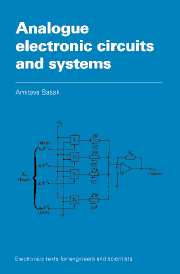8 - Computer aided circuit design
Published online by Cambridge University Press: 05 June 2012
Summary
Objectives
At the end of the study of this chapter a student should be:
familiar with the modelling of different types of active devices
able to develop a suitable model of a device for a particular computer analysis
familiar with nonlinear d.c. analysis, small-signal a.c. analysis and large-signal transient analysis of simple electronic circuits
familiar with the Newton–Raphson algorithms and be able to determine the d.c. operating points of circuits for further analysis, and
familiar with the applications of some computer programs.
In recent years computational methods have been very popular for analysing and designing electronic circuits. It is now possible to design integrated circuits having thousands of transistors on a single chip. Such designs cannot be carried out experimentally at the bench. As very large scale integrated circuits make the fabrication of faster and cheaper computers possible, computer aided design is being used more and more to build such circuits. In this chapter, we will discuss various transistor models and parameters needed for computer analysis, different types of analysis and computer programs.
Computer aided design models
Renewed interest in transistor modelling took place in the sixties and seventies with the advent of computer aided design. Various models which had been developed during this period fell into two main categories, the first being single lump models in which transistor terminal currents are described in terms of quantities determined from terminal measurements; the second category of models is completely described by five basic transistor equations (two continuity equations, two current density equations and Poisson's equation) derived from the donor and acceptor concentration pattern.
- Type
- Chapter
- Information
- Analogue Electronic Circuits and Systems , pp. 266 - 318Publisher: Cambridge University PressPrint publication year: 1991

